2024届高考英语二轮复习非谓语动词课件(31张PPT)
文档属性
| 名称 | 2024届高考英语二轮复习非谓语动词课件(31张PPT) | 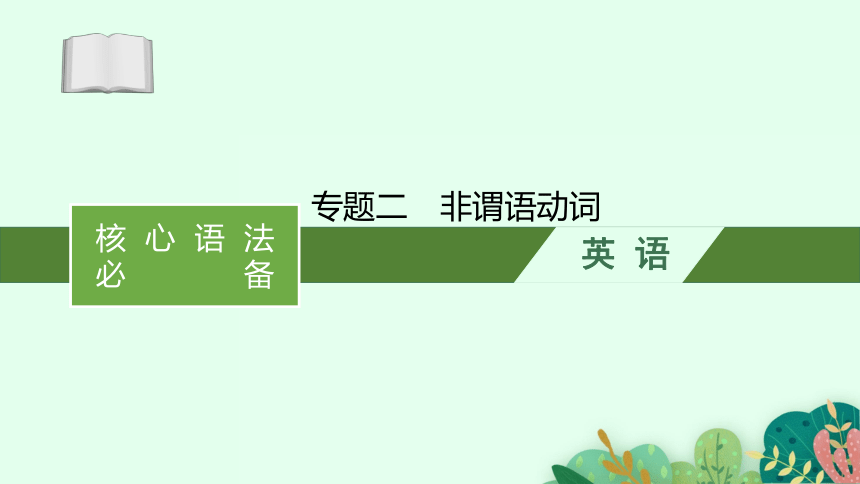 | |
| 格式 | pptx | ||
| 文件大小 | 2.5MB | ||
| 资源类型 | 教案 | ||
| 版本资源 | 通用版 | ||
| 科目 | 英语 | ||
| 更新时间 | 2023-12-21 18:23:21 | ||
图片预览



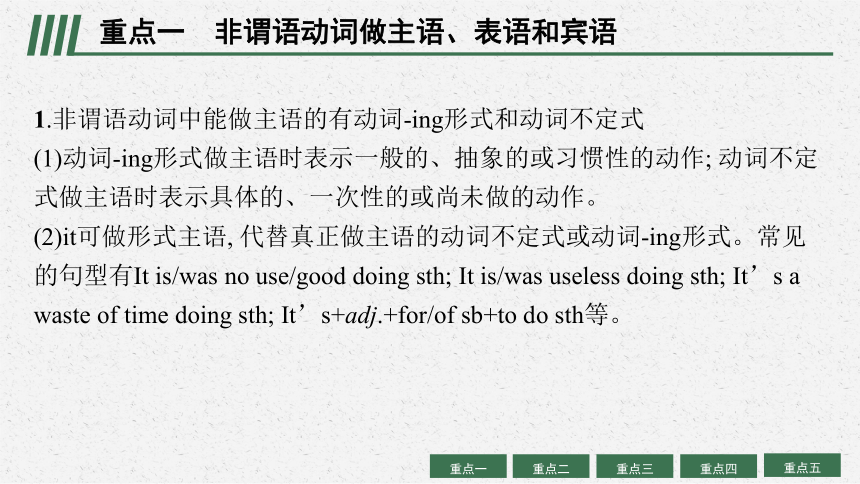
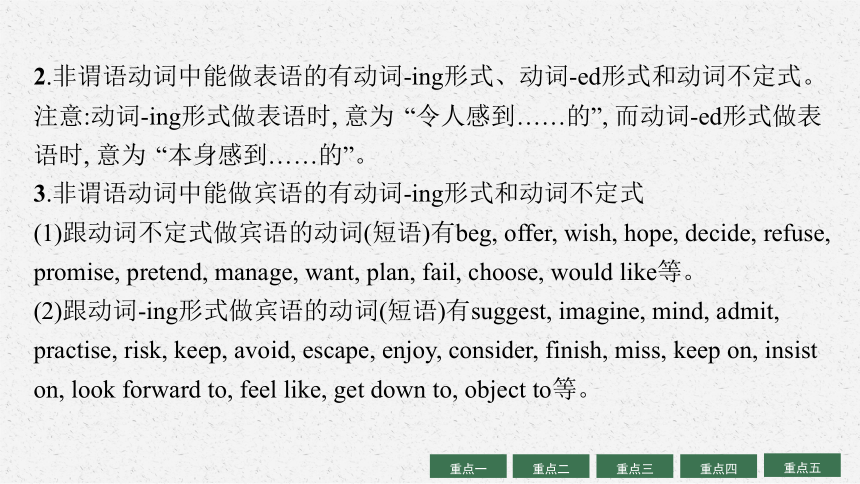
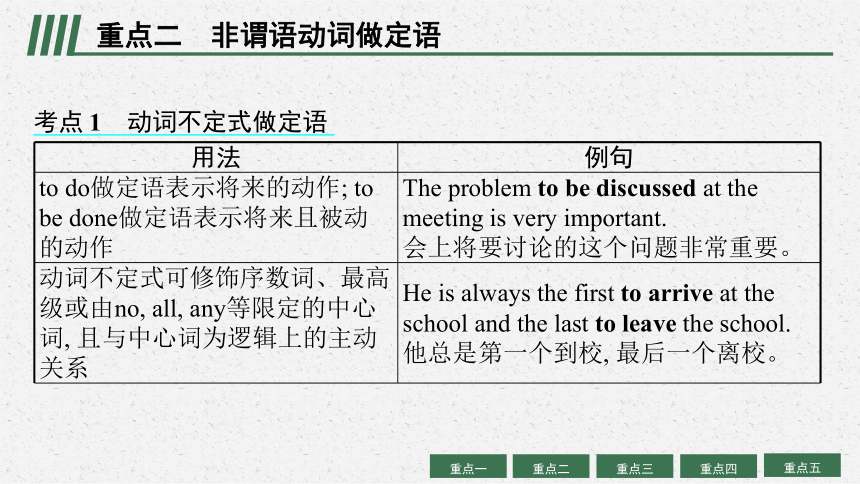
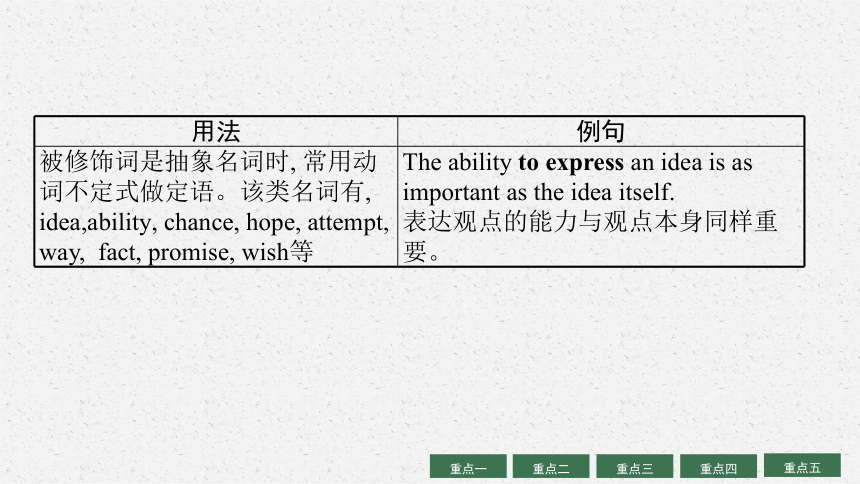
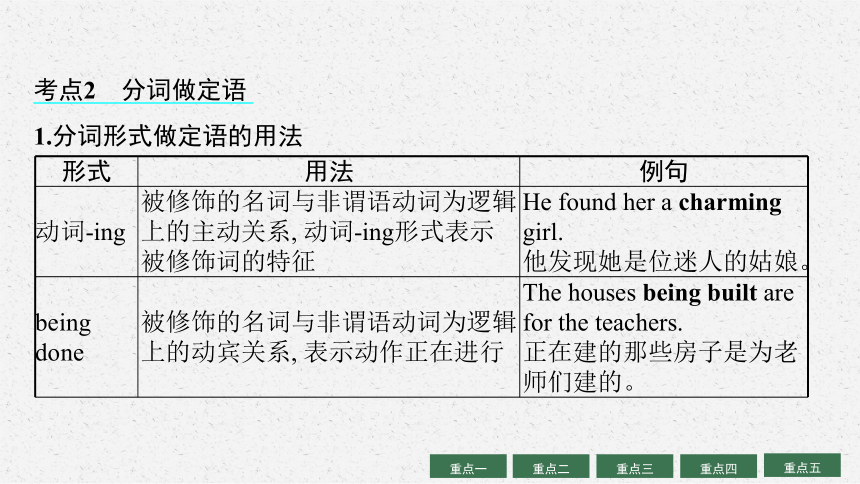
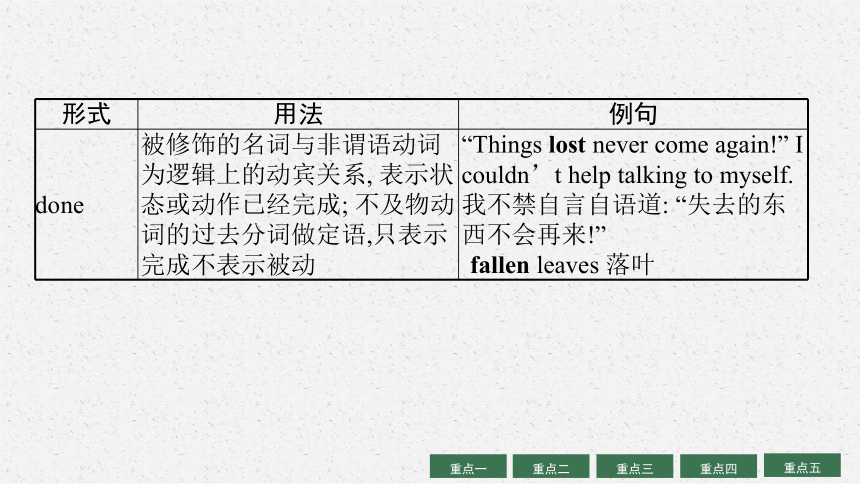
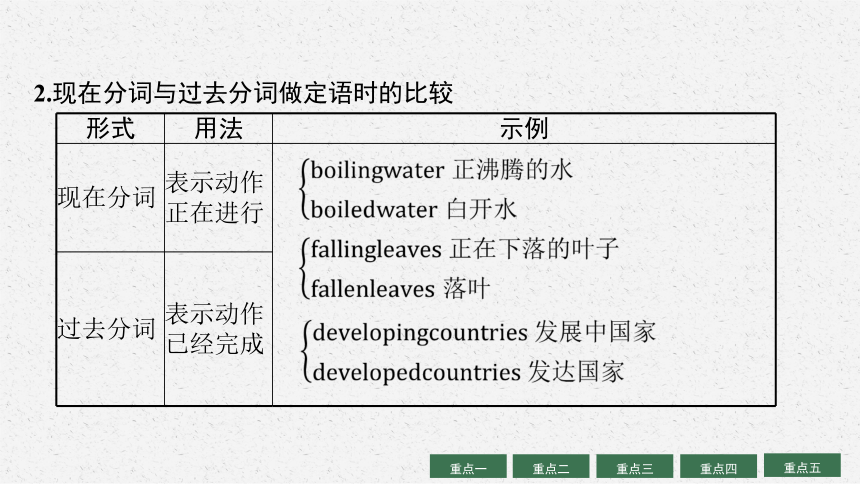
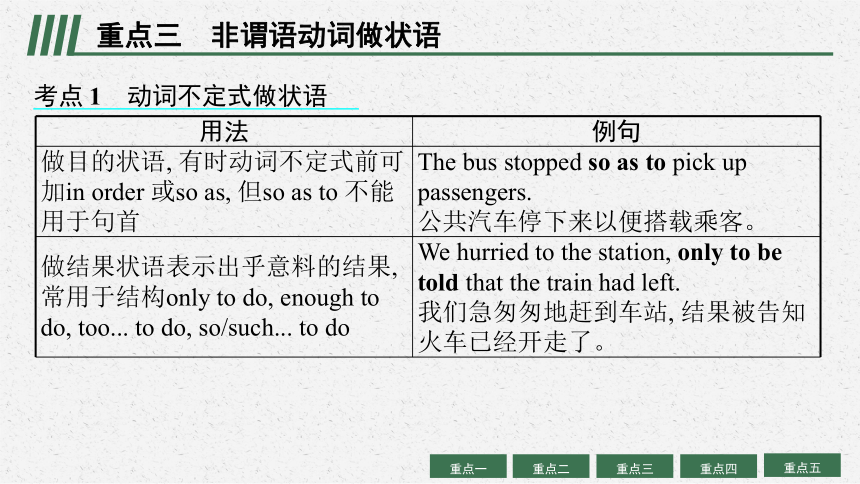
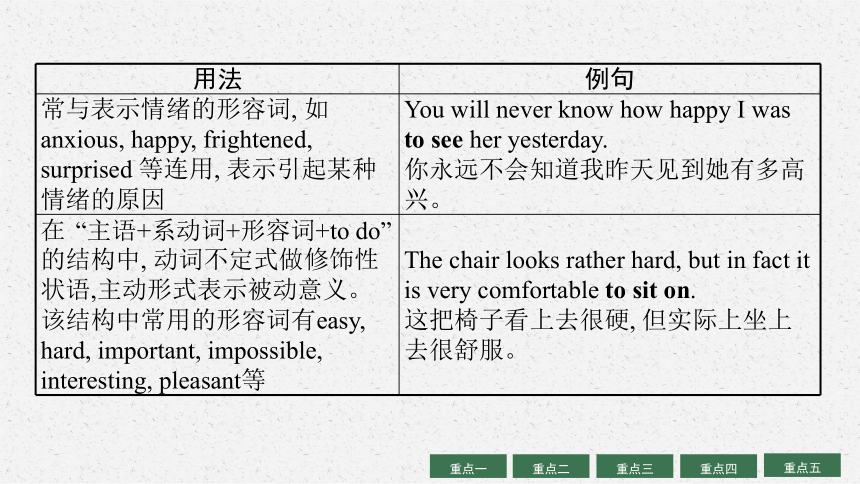
文档简介
(共31张PPT)
核心语法
必备
专题二 非谓语动词
英 语
内容索引
要点精讲 破疑解难
对点演练 精准提升
要点精讲 破疑解难
重点一 非谓语动词做主语、表语和宾语
1.非谓语动词中能做主语的有动词-ing形式和动词不定式
(1)动词-ing形式做主语时表示一般的、抽象的或习惯性的动作; 动词不定式做主语时表示具体的、一次性的或尚未做的动作。
(2)it可做形式主语, 代替真正做主语的动词不定式或动词-ing形式。常见的句型有It is/was no use/good doing sth; It is/was useless doing sth; It’s a waste of time doing sth; It’s+adj.+for/of sb+to do sth等。
2.非谓语动词中能做表语的有动词-ing形式、动词-ed形式和动词不定式。注意:动词-ing形式做表语时, 意为 “令人感到……的”, 而动词-ed形式做表语时, 意为 “本身感到……的”。
3.非谓语动词中能做宾语的有动词-ing形式和动词不定式
(1)跟动词不定式做宾语的动词(短语)有beg, offer, wish, hope, decide, refuse, promise, pretend, manage, want, plan, fail, choose, would like等。
(2)跟动词-ing形式做宾语的动词(短语)有suggest, imagine, mind, admit, practise, risk, keep, avoid, escape, enjoy, consider, finish, miss, keep on, insist on, look forward to, feel like, get down to, object to等。
重点二 非谓语动词做定语
考点 1 动词不定式做定语
用法 例句
to do做定语表示将来的动作; to be done做定语表示将来且被动的动作 The problem to be discussed at the meeting is very important.
会上将要讨论的这个问题非常重要。
动词不定式可修饰序数词、最高级或由no, all, any等限定的中心词, 且与中心词为逻辑上的主动关系 He is always the first to arrive at the school and the last to leave the school.
他总是第一个到校, 最后一个离校。
用法 例句
被修饰词是抽象名词时, 常用动词不定式做定语。该类名词有, idea,ability, chance, hope, attempt, way, fact, promise, wish等 The ability to express an idea is as important as the idea itself.
表达观点的能力与观点本身同样重要。
考点2 分词做定语
1.分词形式做定语的用法
形式 用法 例句
动词-ing 被修饰的名词与非谓语动词为逻辑上的主动关系, 动词-ing形式表示被修饰词的特征 He found her a charming girl.
他发现她是位迷人的姑娘。
being done 被修饰的名词与非谓语动词为逻辑上的动宾关系, 表示动作正在进行 The houses being built are for the teachers.
正在建的那些房子是为老师们建的。
形式 用法 例句
done 被修饰的名词与非谓语动词为逻辑上的动宾关系, 表示状态或动作已经完成; 不及物动词的过去分词做定语,只表示完成不表示被动 “Things lost never come again!” I couldn’t help talking to myself.
我不禁自言自语道: “失去的东西不会再来!”
fallen leaves 落叶
2.现在分词与过去分词做定语时的比较
形式 用法 示例
现在分词 表示动作 正在进行
过去分词 表示动作 已经完成 重点三 非谓语动词做状语
考点 1 动词不定式做状语
用法 例句
做目的状语, 有时动词不定式前可加in order 或so as, 但so as to 不能用于句首 The bus stopped so as to pick up passengers.
公共汽车停下来以便搭载乘客。
做结果状语表示出乎意料的结果, 常用于结构only to do, enough to do, too... to do, so/such... to do We hurried to the station, only to be told that the train had left.
我们急匆匆地赶到车站, 结果被告知火车已经开走了。
用法 例句
常与表示情绪的形容词, 如anxious, happy, frightened, surprised 等连用, 表示引起某种情绪的原因 You will never know how happy I was to see her yesterday.
你永远不会知道我昨天见到她有多高兴。
在 “主语+系动词+形容词+to do” 的结构中, 动词不定式做修饰性状语,主动形式表示被动意义。该结构中常用的形容词有easy, hard, important, impossible, interesting, pleasant等 The chair looks rather hard, but in fact it is very comfortable to sit on.
这把椅子看上去很硬, 但实际上坐上去很舒服。
考点 2 分词做状语
分词做状语时, 其逻辑主语是句子的主语, 一般在句中做时间、原因、结果、方式、条件、伴随、让步等状语。
用法 例句
现在分词做状语时, 与句子主语之间存在逻辑上的主谓关系 More highways have been built in China, making it much easier for people to travel from one place to another.
中国已经修建了更多的公路, 这让人们从一个地方到另一个地方旅行变得更容易。(做结果状语)
过去分词做状语时, 与句子主语之间存在逻辑上的动宾关系 Used with care, one tin will last for six weeks.
如果小心使用, 一罐可以用六个星期。(做条件状语)
提示
(1)某些过去分词(短语)已经形容词化, 它们既不表示被动, 也不表示完成, 而表示一种状态, 如lost, seated, hidden, lost/absorbed in, dressed in, tired of等。
Absorbed in the book, he didn’t notice me enter the room.
他全神贯注地看书, 没有注意到我进了房间。
(2)独立成分做状语时, 其形式不受上下文的影响。常用的有considering..., generally speaking, judging by/from..., supposing that..., providing that..., owing to..., talking/speaking of..., given..., provided that..., to tell the truth, to be honest等。
命题特点
重点四 非谓语动词做补语
考点1 动词不定式做补语
用法 例句
有些动词(短语)后可接不定式做宾语补足语, 即 “动词(短语)+宾语+to do”, 如advise, want, allow, permit, persuade, remind, invite, depend on, call on等 Father advised me to say something.
父亲建议我说点什么。
常用动词不定式做主语补足语的句型有sb/sth be said/believed/known/reported/considered/thought +to do/to have done/to be done/to be doing/to have been done... He is said to have been found in the street.
据说他在大街上被找到了。
考点2 分词做补语
现在分词做宾语补足语时, 句中的宾语与宾语补足语之间是逻辑上的主谓关系; 过去分词做宾语补足语时, 宾语补足语与宾语之间是逻辑上的动宾关系。
They use computers to keep the traffic running smoothly.
他们用电脑保持交通畅通。(the traffic 与run是逻辑上的主谓关系)
Please remember that I want to see it carried out immediately.
请记住, 我想看到它立即执行。(carry out 与it是逻辑上的动宾关系)
提示
常考的分词做补语的几种情况:
(1)感官动词(组), 如see, watch, observe, notice, look at, hear, listen to, feel等后面的宾语补足语常见的有三种非谓语动词形式, 即do/doing/done。do 表示主动(在被动句中需要还原to); doing表示主动或正在进行; done 表示被动或完成。
As I got closer, I saw him kicking his legs in the air and breathing heavily.
当我走近时, 我看见他的腿在空中乱踢, 呼吸沉重。
(2)表示 “使, 让” 的动词, 如make/let/keep/have/get/leave+宾语+补语
结构 to do doing done
make/let+宾语 do × √
keep+宾语 × √ √
have+宾语 have sb do sth 意为“让某人做某事”; have sth to do意为“有某事要做”, to do做后置定语 √(表示主体使客体处于某种状态或一直做某事) √(表示让别人做某事或让某事被做)
get+宾语 √ √ √
leave+宾语 √ √ √
Claire had her luggage checked an hour before her plane left.
在飞机起飞前一个小时, 克莱尔将行李进行了安检。
(3)with/without的复合结构: with+n.+doing(主动、进行)/done(被动、完成)/to do(目的、将来)。
Without anyone noticing, I went into the room.
我走进了房间, 没有人注意到。
重点五 常考固定句式中的非谓语形式
考点1 动词不定式用于固定句式中
用法 例句
主语+系动词+形容词+to do结构, 这类形容词有easy, cheap, comfortable, impossible等, 表示主语的特性或性质,不定式和句子主语之间是逻辑上的动宾关系 In my view, the book is very hard to understand.
依我看, 这本书很难理解。
It is/was+adj.+for sb to do sth结构, 做表语的形容词表示事物的性质, 如difficult, important, necessary等 It is difficult for us to finish writing the composition in an hour.
我们难以在一个小时内写完这篇作文。
用法 例句
It is/was+adj.+of sb to do sth 结构, 做表语的形容词表示人物的特征, 如honest, foolish, nice等 It was generous of him to offer to pay for us.
他主动为我们付钱真是大方。
主语+be likely to do sth结构, 表示 “……可能做某事” Tickets are likely to be expensive.
入场券可能很贵。
It takes(sb) some time to do sth结构, 表示 “(某人)花时间做某事” It takes about half an hour to get to the airport.
到机场大概需要半小时。
疑问词(who, what, where, when, how等)+to do 结构, 该结构在句中可充当主语、宾语、表语等 He didn’t know how to work out the question, so he asked the teacher for help.
他不知道如何解这道题, 因此他向老师求助。
考点2 动词-ing形式用于固定句式中
用法 例句
It’s no good/no use/no fun/no pleasure doing sth 做某事没好处/没用处/没意思/不高兴 It is no use complaining without taking action.
不采取行动而只是抱怨是没有用的。
It’s useless/worthwhile doing sth 做某事没用/值得 It is worthwhile making an appointment before you go.
你去之前预约一下是值得的。
It’s a waste of time/money doing sth 做某事浪费时间/钱 It is a waste of time talking with such a stubborn man.
和如此固执的人交谈浪费时间。
用法 例句
spend/waste time/money(in) doing sth 花时间/钱做某事 I spent too much time watching television.
我看电视花的时间太多了。
have difficulty/trouble/fun(in) doing sth 做某事有困难/费力/好玩 I have difficulty(in) making myself understood.
我很难让别人理解我的意思。
对点演练 精准提升
1.(2023·广西北海高三一模)A group of young people from the city come together (produce) a positive comedy programme.
Ⅰ.单句语法填空
2.My experience awakened me to not only the limitations (place) on ourselves, but also our amazing ability to adapt.
3.An ancient temple (date) back to the Qing Dynasty was destroyed in flames, (cause) concerns about the effective protection of cultural remains.
4.Red or processed meat can increase your chances of (get) this disease.
to produce
placed
dating
causing
getting
5.On tea plantations, (pull) the leaves easily, people cut them back to a bush of about a metre in height.
6.The giant panda, also (know) as the panda bear or simply panda, is a bear native to south central China.
7.However, most of the fires this year are believed (cause) by those farmers, who use fire as a traditional way to clean land.
to pull
known
to be caused
Ⅱ.微语法填空
1.Poetry is a beautiful art form. Its power lies in the ability ①_________ (transform) ordinary experiences by capturing a moment or emotion. ②_____ (write) poetry is a privilege and struggle. That is partly because we need to create ourselves in a new way of ③ (observe) the world. Most of our time at the desk is spent ④ (struggle) with our imagination, and we know that a successful poem arrives on the back of failure. There are moments when an idea will not translate onto paper. Yet, failure is good, because every ⑤ (abandon) line we painstakingly remove prepares us for the ripe poem around the corner.
①答案 to transform
解析 ability后常用动词不定式做后置定语, 故填to transform。
②答案 Writing
解析 分析句子结构可知, write在句中应用非谓语动词形式, 因本句缺少主语, 且设空处位于句首, 单词首字母要大写, 故填Writing。
③答案 observing
解析 设空处前是介词of, 应用动词-ing形式做宾语, a way of doing sth “做某事的一种方法”, 故填observing。
④答案 struggling
解析 spent的宾语是Most of our time, 所以此处是spend time (in) doing sth结构, 此处应填动词-ing形式做宾语, 故填struggling。
⑤答案 abandoned
解析 分析句子结构可知, 设空处应用非谓语动词形式, 因与line是逻辑上的动宾关系, 应用动词-ed形式做定语, 表示 “废弃的”, 故填abandoned。
2. I’ll find a way ① (improve) on my own so that I can make the team next year. I joined a volunteer club instead. Every Wednesday, we work at a soup kitchen and hand out food to homeless people in the community.
I know I’ll have to work harder as a senior high school student and get used to ② (be) responsible for a lot more. I’m a bit worried about keeping up with the other students in my advanced course, and it’ll be quite difficult ③ (get) used to all the homework. Still, I’m happy to be here. ④ (study) hard isn’t always fun, but I’ll be well ⑤ (prepare) for university or whatever comes in the future.
①答案 to improve
解析 a way to do sth 意为“做……的方法”, 此处用动词不定式做定语。
②答案being
解析 get used to 意为“习惯于……”, 短语中的to为介词, 后接动词-ing形式做宾语。
③答案to get
解析 该处动词不定式做主语, 用于it+be+adj.+to do sth句型中, 句首的it是形式主语。
④答案Studying
解析 该处为动词-ing形式做主语。
⑤答案prepared
解析 be well prepared for 为固定搭配, 意为“为……做好了准备”。
核心语法
必备
专题二 非谓语动词
英 语
内容索引
要点精讲 破疑解难
对点演练 精准提升
要点精讲 破疑解难
重点一 非谓语动词做主语、表语和宾语
1.非谓语动词中能做主语的有动词-ing形式和动词不定式
(1)动词-ing形式做主语时表示一般的、抽象的或习惯性的动作; 动词不定式做主语时表示具体的、一次性的或尚未做的动作。
(2)it可做形式主语, 代替真正做主语的动词不定式或动词-ing形式。常见的句型有It is/was no use/good doing sth; It is/was useless doing sth; It’s a waste of time doing sth; It’s+adj.+for/of sb+to do sth等。
2.非谓语动词中能做表语的有动词-ing形式、动词-ed形式和动词不定式。注意:动词-ing形式做表语时, 意为 “令人感到……的”, 而动词-ed形式做表语时, 意为 “本身感到……的”。
3.非谓语动词中能做宾语的有动词-ing形式和动词不定式
(1)跟动词不定式做宾语的动词(短语)有beg, offer, wish, hope, decide, refuse, promise, pretend, manage, want, plan, fail, choose, would like等。
(2)跟动词-ing形式做宾语的动词(短语)有suggest, imagine, mind, admit, practise, risk, keep, avoid, escape, enjoy, consider, finish, miss, keep on, insist on, look forward to, feel like, get down to, object to等。
重点二 非谓语动词做定语
考点 1 动词不定式做定语
用法 例句
to do做定语表示将来的动作; to be done做定语表示将来且被动的动作 The problem to be discussed at the meeting is very important.
会上将要讨论的这个问题非常重要。
动词不定式可修饰序数词、最高级或由no, all, any等限定的中心词, 且与中心词为逻辑上的主动关系 He is always the first to arrive at the school and the last to leave the school.
他总是第一个到校, 最后一个离校。
用法 例句
被修饰词是抽象名词时, 常用动词不定式做定语。该类名词有, idea,ability, chance, hope, attempt, way, fact, promise, wish等 The ability to express an idea is as important as the idea itself.
表达观点的能力与观点本身同样重要。
考点2 分词做定语
1.分词形式做定语的用法
形式 用法 例句
动词-ing 被修饰的名词与非谓语动词为逻辑上的主动关系, 动词-ing形式表示被修饰词的特征 He found her a charming girl.
他发现她是位迷人的姑娘。
being done 被修饰的名词与非谓语动词为逻辑上的动宾关系, 表示动作正在进行 The houses being built are for the teachers.
正在建的那些房子是为老师们建的。
形式 用法 例句
done 被修饰的名词与非谓语动词为逻辑上的动宾关系, 表示状态或动作已经完成; 不及物动词的过去分词做定语,只表示完成不表示被动 “Things lost never come again!” I couldn’t help talking to myself.
我不禁自言自语道: “失去的东西不会再来!”
fallen leaves 落叶
2.现在分词与过去分词做定语时的比较
形式 用法 示例
现在分词 表示动作 正在进行
过去分词 表示动作 已经完成 重点三 非谓语动词做状语
考点 1 动词不定式做状语
用法 例句
做目的状语, 有时动词不定式前可加in order 或so as, 但so as to 不能用于句首 The bus stopped so as to pick up passengers.
公共汽车停下来以便搭载乘客。
做结果状语表示出乎意料的结果, 常用于结构only to do, enough to do, too... to do, so/such... to do We hurried to the station, only to be told that the train had left.
我们急匆匆地赶到车站, 结果被告知火车已经开走了。
用法 例句
常与表示情绪的形容词, 如anxious, happy, frightened, surprised 等连用, 表示引起某种情绪的原因 You will never know how happy I was to see her yesterday.
你永远不会知道我昨天见到她有多高兴。
在 “主语+系动词+形容词+to do” 的结构中, 动词不定式做修饰性状语,主动形式表示被动意义。该结构中常用的形容词有easy, hard, important, impossible, interesting, pleasant等 The chair looks rather hard, but in fact it is very comfortable to sit on.
这把椅子看上去很硬, 但实际上坐上去很舒服。
考点 2 分词做状语
分词做状语时, 其逻辑主语是句子的主语, 一般在句中做时间、原因、结果、方式、条件、伴随、让步等状语。
用法 例句
现在分词做状语时, 与句子主语之间存在逻辑上的主谓关系 More highways have been built in China, making it much easier for people to travel from one place to another.
中国已经修建了更多的公路, 这让人们从一个地方到另一个地方旅行变得更容易。(做结果状语)
过去分词做状语时, 与句子主语之间存在逻辑上的动宾关系 Used with care, one tin will last for six weeks.
如果小心使用, 一罐可以用六个星期。(做条件状语)
提示
(1)某些过去分词(短语)已经形容词化, 它们既不表示被动, 也不表示完成, 而表示一种状态, 如lost, seated, hidden, lost/absorbed in, dressed in, tired of等。
Absorbed in the book, he didn’t notice me enter the room.
他全神贯注地看书, 没有注意到我进了房间。
(2)独立成分做状语时, 其形式不受上下文的影响。常用的有considering..., generally speaking, judging by/from..., supposing that..., providing that..., owing to..., talking/speaking of..., given..., provided that..., to tell the truth, to be honest等。
命题特点
重点四 非谓语动词做补语
考点1 动词不定式做补语
用法 例句
有些动词(短语)后可接不定式做宾语补足语, 即 “动词(短语)+宾语+to do”, 如advise, want, allow, permit, persuade, remind, invite, depend on, call on等 Father advised me to say something.
父亲建议我说点什么。
常用动词不定式做主语补足语的句型有sb/sth be said/believed/known/reported/considered/thought +to do/to have done/to be done/to be doing/to have been done... He is said to have been found in the street.
据说他在大街上被找到了。
考点2 分词做补语
现在分词做宾语补足语时, 句中的宾语与宾语补足语之间是逻辑上的主谓关系; 过去分词做宾语补足语时, 宾语补足语与宾语之间是逻辑上的动宾关系。
They use computers to keep the traffic running smoothly.
他们用电脑保持交通畅通。(the traffic 与run是逻辑上的主谓关系)
Please remember that I want to see it carried out immediately.
请记住, 我想看到它立即执行。(carry out 与it是逻辑上的动宾关系)
提示
常考的分词做补语的几种情况:
(1)感官动词(组), 如see, watch, observe, notice, look at, hear, listen to, feel等后面的宾语补足语常见的有三种非谓语动词形式, 即do/doing/done。do 表示主动(在被动句中需要还原to); doing表示主动或正在进行; done 表示被动或完成。
As I got closer, I saw him kicking his legs in the air and breathing heavily.
当我走近时, 我看见他的腿在空中乱踢, 呼吸沉重。
(2)表示 “使, 让” 的动词, 如make/let/keep/have/get/leave+宾语+补语
结构 to do doing done
make/let+宾语 do × √
keep+宾语 × √ √
have+宾语 have sb do sth 意为“让某人做某事”; have sth to do意为“有某事要做”, to do做后置定语 √(表示主体使客体处于某种状态或一直做某事) √(表示让别人做某事或让某事被做)
get+宾语 √ √ √
leave+宾语 √ √ √
Claire had her luggage checked an hour before her plane left.
在飞机起飞前一个小时, 克莱尔将行李进行了安检。
(3)with/without的复合结构: with+n.+doing(主动、进行)/done(被动、完成)/to do(目的、将来)。
Without anyone noticing, I went into the room.
我走进了房间, 没有人注意到。
重点五 常考固定句式中的非谓语形式
考点1 动词不定式用于固定句式中
用法 例句
主语+系动词+形容词+to do结构, 这类形容词有easy, cheap, comfortable, impossible等, 表示主语的特性或性质,不定式和句子主语之间是逻辑上的动宾关系 In my view, the book is very hard to understand.
依我看, 这本书很难理解。
It is/was+adj.+for sb to do sth结构, 做表语的形容词表示事物的性质, 如difficult, important, necessary等 It is difficult for us to finish writing the composition in an hour.
我们难以在一个小时内写完这篇作文。
用法 例句
It is/was+adj.+of sb to do sth 结构, 做表语的形容词表示人物的特征, 如honest, foolish, nice等 It was generous of him to offer to pay for us.
他主动为我们付钱真是大方。
主语+be likely to do sth结构, 表示 “……可能做某事” Tickets are likely to be expensive.
入场券可能很贵。
It takes(sb) some time to do sth结构, 表示 “(某人)花时间做某事” It takes about half an hour to get to the airport.
到机场大概需要半小时。
疑问词(who, what, where, when, how等)+to do 结构, 该结构在句中可充当主语、宾语、表语等 He didn’t know how to work out the question, so he asked the teacher for help.
他不知道如何解这道题, 因此他向老师求助。
考点2 动词-ing形式用于固定句式中
用法 例句
It’s no good/no use/no fun/no pleasure doing sth 做某事没好处/没用处/没意思/不高兴 It is no use complaining without taking action.
不采取行动而只是抱怨是没有用的。
It’s useless/worthwhile doing sth 做某事没用/值得 It is worthwhile making an appointment before you go.
你去之前预约一下是值得的。
It’s a waste of time/money doing sth 做某事浪费时间/钱 It is a waste of time talking with such a stubborn man.
和如此固执的人交谈浪费时间。
用法 例句
spend/waste time/money(in) doing sth 花时间/钱做某事 I spent too much time watching television.
我看电视花的时间太多了。
have difficulty/trouble/fun(in) doing sth 做某事有困难/费力/好玩 I have difficulty(in) making myself understood.
我很难让别人理解我的意思。
对点演练 精准提升
1.(2023·广西北海高三一模)A group of young people from the city come together (produce) a positive comedy programme.
Ⅰ.单句语法填空
2.My experience awakened me to not only the limitations (place) on ourselves, but also our amazing ability to adapt.
3.An ancient temple (date) back to the Qing Dynasty was destroyed in flames, (cause) concerns about the effective protection of cultural remains.
4.Red or processed meat can increase your chances of (get) this disease.
to produce
placed
dating
causing
getting
5.On tea plantations, (pull) the leaves easily, people cut them back to a bush of about a metre in height.
6.The giant panda, also (know) as the panda bear or simply panda, is a bear native to south central China.
7.However, most of the fires this year are believed (cause) by those farmers, who use fire as a traditional way to clean land.
to pull
known
to be caused
Ⅱ.微语法填空
1.Poetry is a beautiful art form. Its power lies in the ability ①_________ (transform) ordinary experiences by capturing a moment or emotion. ②_____ (write) poetry is a privilege and struggle. That is partly because we need to create ourselves in a new way of ③ (observe) the world. Most of our time at the desk is spent ④ (struggle) with our imagination, and we know that a successful poem arrives on the back of failure. There are moments when an idea will not translate onto paper. Yet, failure is good, because every ⑤ (abandon) line we painstakingly remove prepares us for the ripe poem around the corner.
①答案 to transform
解析 ability后常用动词不定式做后置定语, 故填to transform。
②答案 Writing
解析 分析句子结构可知, write在句中应用非谓语动词形式, 因本句缺少主语, 且设空处位于句首, 单词首字母要大写, 故填Writing。
③答案 observing
解析 设空处前是介词of, 应用动词-ing形式做宾语, a way of doing sth “做某事的一种方法”, 故填observing。
④答案 struggling
解析 spent的宾语是Most of our time, 所以此处是spend time (in) doing sth结构, 此处应填动词-ing形式做宾语, 故填struggling。
⑤答案 abandoned
解析 分析句子结构可知, 设空处应用非谓语动词形式, 因与line是逻辑上的动宾关系, 应用动词-ed形式做定语, 表示 “废弃的”, 故填abandoned。
2. I’ll find a way ① (improve) on my own so that I can make the team next year. I joined a volunteer club instead. Every Wednesday, we work at a soup kitchen and hand out food to homeless people in the community.
I know I’ll have to work harder as a senior high school student and get used to ② (be) responsible for a lot more. I’m a bit worried about keeping up with the other students in my advanced course, and it’ll be quite difficult ③ (get) used to all the homework. Still, I’m happy to be here. ④ (study) hard isn’t always fun, but I’ll be well ⑤ (prepare) for university or whatever comes in the future.
①答案 to improve
解析 a way to do sth 意为“做……的方法”, 此处用动词不定式做定语。
②答案being
解析 get used to 意为“习惯于……”, 短语中的to为介词, 后接动词-ing形式做宾语。
③答案to get
解析 该处动词不定式做主语, 用于it+be+adj.+to do sth句型中, 句首的it是形式主语。
④答案Studying
解析 该处为动词-ing形式做主语。
⑤答案prepared
解析 be well prepared for 为固定搭配, 意为“为……做好了准备”。
